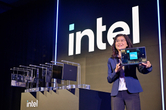
Intel has just given us an early look of “Lunar Lake” ahead of the expected announcement at the upcoming Intel Tech Tour and Computex 2024. Since its initial demo last fall, the next-generation mobile CPU is being touted as a highly efficient mobile processor. A low-power successor to Meteor Lake, Lunar Lake is going to be Intel’s second mainstream tiled chipset with new CPU and GPU architectures, offering improvements over its predecessor.
Table of Contents
What’s new?
Lunar Lake is going to feature a reworked architecture and according to Intel, we can expect a significant boost in AI performance. The company is yet to confirm the manufacturing processes that is being used for Lunar Lake. However, we do know that it will be featuring a more compact design with three tiles: SoC, compute, and a third empty tile used for structural silicon. Additionally, Lunar Lake uses on-package LPDDR5X memory to reduce memory bus length and make the overall SoC + RAM package more compact.

The biggest change is the inclusion of a brand new NPU (Neural Processing Unit) that is capable of over 45 TOPS (Tera Operations per Second). This makes it four times more powerful than the NPU on Meteor Lake rated at 11 TOPS. Additionally, thanks to the new GPU architecture, this can expand to over 100 TOPS of total power across the entire chip. We continue to see a hybrid core architecture with upgraded P-cores using the Lion Cove architecture and the E-cores using Skymont, the successor to Crestmont. Although Intel hasn’t provided extensive details, it expects significant performance improvements over Meteor Lake, highlighting enhancements in IPC (Instructions per cycle) and performance-per-watt.
One SKU configuration for Lunar Lake includes a 4P + 4E design with additional low-power E-cores, compared to Meteor Lake-U’s 2P + 8E + 2LP setup. This should result in a more balanced design with more P-cores and fewer overall CPU cores.
Lunar Lake will also feature the Xe2 GPU architecture, similar to Intel’s upcoming Battlemage discrete GPUs. This includes the Xe Matrix eXtension (XMX) cores, which was notably missing in Meteor Lake’s Xe-LPG design. This enhancement should help Intel to align the iGPU closer to desktop versions, support high-quality XeSS temporal image upscaling, and boost raster graphics performance by 50 percent, significantly improving graphics capability.
What about performance?
As a quick comparison, Lunar Lake is claimed to be 40 percent faster in Stable Diffusion 1.5 running on the GIMP photo editor when compared to the Snapdragon X Elite. Intel’s slides also suggest that Lunar Lake will offer better core performance than the X Elite and AMD’s Ryzen 7 8840U, although no specific numbers were shared. GPU performance of an undisclosed 17W Lunar Lake chip when compared to a 15W Core Ultra 7 165U results in 50 percent better performance in 3DMark Time Spy.
When can we expect a launch?
Intel is expected to share broader details around the Lunar Lake architecture and SKUs in June during Computex 2024 in Taiwan. As per various reports, we might also get a preview of Arrow Lake, Intel’s next-gen CPUs for desktops. Production of Lunar Lake is said to be on course with an aim to deliver the chips to manufacturers by Q3 2024, eventually reaching markets by Q4.
Intel also shared that Meteor Lake CPUs are gaining significant recognition among developers, with increasing experiences and optimizations for Intel’s “AI PC” platforms. Its first-generation Core Ultra 100 CPU lineup under Meteor Lake, has surpassed 7 million units shipped. The company hopes to reach 40 million units shipped by the end of 2024, and over 100 million units shipped by 2025 leveraged by Meteor Lake, Arrow Lake, and Lunar Lake CPUs, and other projects.














